These books haven't necessarily been uploaded to antiqbook yet. So, if you order through antiqbook and get a message claiming the book has been sold, email in case that isn't true.

These books haven't necessarily been uploaded to antiqbook yet. So, if you order through antiqbook and get a message claiming the book has been sold, email in case that isn't true.

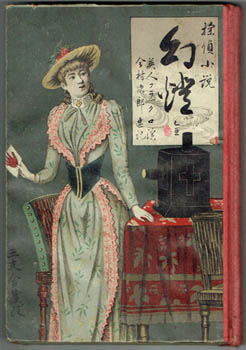
Henry James Black. (Kairakutei Burakku). 幻燈 : 探偵小説 : 英人ブラック口演 - 今村次郎速記 [Gento : Tantei Shosetsu : Hideto Burakku Koen - Imamura Jiro Sokki]. Tokyo, San'yusha 1892 (Meiji 25). Octavo (185x130mm) publisher's cloth backed boards with colour lithograph front cover; 98pp, three double page illustrations. A small hole in the paper on the front cover, some bubbling of the paper, minor signs of being scuffed about. A most pleasing copy, fresh and bright inside, of a book made to be read to pieces. sold
First edition of perhaps the most remarkable detective novel ever. Where to start? This is a London set murder mystery solved by an amateur detective using fingerprints - or a handprint - and a magic lantern (gento) that was told as a serial story to a Japanese audience by a gay Australian who became a professional Japanese story teller, taken down in shorthand and turned into a book. I probably don't need to add much to that but I will.
This is the second known book to use fingerprints to solve a crime. The hero of fingerprint detecting is of course Mark Twain who solved a story within the story with a thumb print in his Life on the Mississippi in 1883 and followed it up with Pudd'nhead Wilson in 1893-4 - a year after Galton's Finger Prints was published.
Now to Henry Black: Black was born in Adelaide and arrived in Japan in 1865 at the age of almost seven - his father, up until now a singer, had bought into the Japan Herald. Henry seems to have grown into something of a no-hoper in the eyes of some of his family at least and rather than settle to respectable work became first a proponent of progressive reform, like his father, then a professional rakugoka - story teller - and even a kabuki actor playing women. His reaction to his siblings' disapproval was to change his name to Kairakutei Burakku (Pleasure Black), marry a Japanese woman and become a Japanese citizen. Ian McArthur, Black's biographer, quotes from a police report made at this time that he was living in "virtually a husband and wife relationship" with a young Japanese man but otherwise there was nothing untoward to worry about.
At the height of his fame - 1891 and 92 - maybe six or seven of these stenographic novels were published and other stories appeared in newspapers. It's a bit hard to unravel as a couple appeared more than once with different titles. Even the concise and acerbic Edogawa Rampo gets muddled and misled trying to work out a bibliography at the end of his 1951 essay translated as Fingerprint Novels of the Meiji Era. He cites another essayist who wrote on Black and said he had five* of his books, Edogawa has only three but this is one of them - hence his essay.
This handful of detective stories or thrillers was bracketed by two adaptations of novels: Mrs Braddon's Flower and Weed in 1886 and Dickens' Oliver Twist in 1895. Of the thrillers from these two boom years, two are known to be adapted from stories by Mrs Braddon and one from a story by Fortune du Boisgobey. The others - most particularly this, the jewel in the crown - have no known antecedent. I would like to suggest that scholars chase connections with Henry Faulds - the disgruntled pioneer of fingerprint studies - who lived in Japan through the 1870s and 80s and published his first paper in Nature in 1880 - the paper that Galton said had no part in his discoveries. The bright spark in Black's story spent time in China and Japan where he learnt about prints as a form of identification - exactly as Faulds did in Japan.
These shorthand books - sokkibon - were hugely popular, distributed largely through lending libraries and have a pitiful survival rate. They are credited with playing a large part in transforming Japanese literature from the classical and formal to colloquial. This is also a 'ball cover' (boru hyoshi) book - I can't find out why they are called that - the Japanese equivalent of a yellowback: flimsy western style bindings with lithograph covers that usually only survive in such good shape when they are exceedingly dull. I've found no copies of any of Black's books outside Japan and very few inside.
*He lost his copy of Gento during the war.
![]()
You can email an inquiry
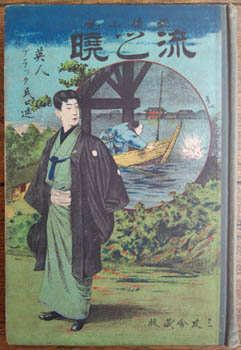
Henry James Black. (Kairakutei Burakku). 流の暁 : 探偵小説 [Nagare no Akatsuki : Tantei Shotetsu]. Tokyo, San'yusha 1891 (Meiji 24). Octavo (185x130mm) publisher's cloth backed boards with colour lithograph front cover; 263pp, 18 double page illustrations. Expected browning of the paper, a couple of signatures a bit sprung - which I think has more to do with the binding than use. A rather good copy, the cover especially good. sold
First edition of this detective story told as a serial to an audience by an Australian who became a professional Japanese story teller and actor, taken down in shorthand and published as this book.
This complicated murder mystery - no antecedent has been traced - starts with a French aristocrat fleeing to England to escape the terror. Then come twin boys to a now abandoned mother; one gets thrown in the Thames and of course they meet as adults. Then comes embezzlement, murder, impersonation and unsuspected incest (the half sister - keep up!) and final exposure by the detective who was made suspicious by the dead book keeper having such rough hands - shades of Black's fingerprint novel to come next year. The illustrations are baffling to anyone expecting the characters to be in England or France but I'm sure it makes sense if you read Japanese.

BANERJEA, S.B. [ie S.B. Bandyopadhyay]. Indian Detective Stories. London, Gay & Hancock [1911]. Octavo publisher's colour illustrated wrapper; viii,275,[3]pp. Browning of the cheap paper, some bumps and marks to the cover; a pretty good copy. Au$400
Only edition, I believe. Banerjea seems to be the first Anglo-Indian writer of detective stories. His debut was The Adventures of Mrs. Russell in 1909 with five stories of the lady detective's triumphs. Those five are repeated here with fifteen more.
His attempt to break into the sometimes lucrative English detective market - despite his canny use of a heroine - didn't work. His books are listed over and over in academic studies of Anglo-Indian literature but I only found one writer who had read some.
OCLC, Copac et al find four copies - the usual British deposit libraries. Some date the book [1912] but it was in Luzac's list in 1911.

DEFOE, Daniel. The Life and Adventures of Robinson Crusoe, ... Translated into the New Zealand Language under the direction of the Government. [He Korero Tipuna Pakeha No Mua, Ko Ropitini Kuruho, Tona Ingoa.] Wellington, printed at the Independant Office 1852. Octavo, contemporary cloth with the original printed wrappers bound in; [8],157pp and four lithograph plates by T.S. Ralph. Separate title pages in Maori and English.
Neatly annotated with paragraphs marked with red dots, sections numbered in pencil and some authoritive looking corrections to the text. An attractive copy. Au$1,750
I gather from the preface that it was decided that Robinson Crusoe so accords with Maori narrative that it is likely "to be within their comprehension." It should have been a welcome respite from all the scripture offered by the missionaries but according to 'Books in Maori' fiction was not valued. I think it was while before anything so frivolous was offered again.
An early entrant for secular literature in any Pacific language, it is an abridgement, translated by H. Tacy Kemp. I'm told there are some small but not insignificant changes to passages about Crusoe and Friday.

GULL, William Withey. A Collection of the Published Writings ... edited and arranged by Theodore Dyke Acland. London, New Sydenham Society 1894-96. Two volumes octavo blindstamped cloth; xii,600; lxxii,184pp, 20 plates and a few illustrations in the first, 2 plates in the second. A few small flaws to the cloth of the first volume; a bit of foxing at the beginning of the second; quite a good pair. I: Medical Papers. II: Memoir and Addresses. Au$200
About a generation ago Gull emerged as a strong candidate for Jack the Ripper despite all and any evidence. Usually this is the most convincing argument for the prosecution: unless it was true why would so much evidence be needed to refute the charge? But sadly I conclude that we can view Gull only as a distinguished medico who, among other achievements, identified anorexia.

Morita Hisashi. 世界夢旅行双六 [Sekai Yume Ryoko Sugoroku]. Tokyo, Sekai Shonen 1919 (Taisho 8). Colour broadside 79x54cm. Used with several tears in folds and an old repair. Au$100
A good sugoroku but not a great copy, this dream adventure was the new year gift from the boys' magazine Sekai Shonen.
Morita was a busy illustrator and art director for the Takarazuka Revue through the twenties.

Otake Kokkan. 小学教科双六 [Shogaku Kyoka Sugoroku]. Tokyo, Shonen Sekei 1907 (Meiji 40). Colour broadside 78x54cm. Quite a nice copy. Au$385
School life for small boys and girls; this was the new year gift from the boys' magazine Shonen Sekai. Boys and girls learn to read but then their ways seem to part: boys learn about rats while girls do flowers, boys learn to count while girls sew, boys write while girls fold paper.
Otake by 1907 was a well regarded, prize winning, Nihonga painter who was firm about maintaining Japanese tradition but like many such artists was a busy producer of prints and illustrator of magazines, books and advertisements.
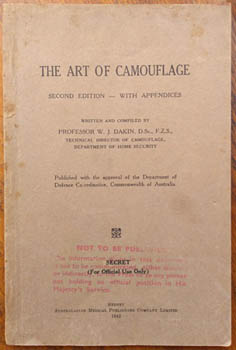
DAKIN, W.J. The Art of Camouflage. Second edition - with appendices. Sydney, Australasian Medical Publishing Company 1942. Octavo publisher's printed wrapper; 83pp, numerous illustrations, one colour. Signs of use; a most acceptable copy. Au$250
A hard book to find these days, this is Australia's major contribution to the slender literature of this elusive subject - from an eminent biologist which makes sense and printed by a medical publisher which might make sense, somehow. Until this local literature consisted of reprints of two English military manuals. The first edition appeared the year before but profound changes were called for quickly and this edition has been "almost rewritten".
The book has "Secret (for official use only)" printed on the front cover - a command reinforced by a red stamp telling us not to communicate this to the press or any unofficial person.

Grosseteste. CROMBIE, A.C. Robert Grosseteste and the Origins of Experimental Science 1100 - 1700. Oxford Univ Press 1953. Octavo, very good in publisher's cloth; x,369pp, 16 plates. Au$65
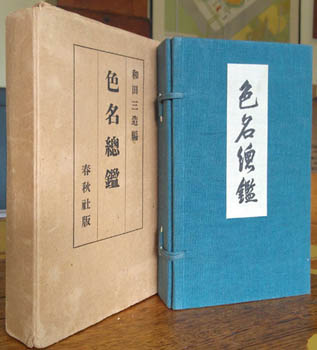
Wada Sanzo. 色名総鑑 [Shikimei Sokan]. Tokyo, Shunjusha 1931 (Showa 6). 195x115mm publisher's cloth case with title label with 160 mounted colour samples on 56 accordian folding card leaves and wrappered book; 178pp and some tables (two folding). The usual browning or offsetting of the card and still a nice copy in the original printed card outer folding case.
Colour samples named in Japanese, English and occasionally French or German; two of the tables are multi language lists of colour names. The top edge of the colour cards are gilded and the apparently plain paper lining of the case has a pattern of transparent glazed shapes printed on it. Au$475
First edition of Wada's first serious attempt at colour nomenclature. Wada, though at the top of the art ladder in Japan insisted on pursuing new directions and founded the Japan Standard Color Association, now the Japan Color Research Institute, in 1927. In these early years science, art and aesthetics went hand in hand.
Yet another significant book missed by the peurile Osborne 'Books on Colour Since 1500'.

STEUART, Sir Henry. The Planter's Guide; or a practical essay on the best method giving immediate effect to wood, by the removal of large trees and underwood; Edinburgh, Blackwood &c 1828. Octavo, uncut in original cloth backed boards, printed spine label; [8],xxii,473pp & publisher's list, 5 plates, the frontispiece double page. A little spotting of the plates. Au$300
First edition; not a rare book but a pretty outstanding copy and not unimportant in the history of landscape. Steuart sits for the most part in the mainstream of the picturesque though he was savaged for his advocacy of the oval and circle as a natural form - which hearkens back to earlier platonic ideals. I'm told this slip of judgment was excised from later editions.
Where his influence is important is in his practical advice, drawn from his own work on his estate at Allanton, showing how the removal and replanting of large trees made feasible the re-ordering of entire landsapes. Re-ordering nature is of course nothing new but it had taken vast amounts of money, labour and, most important, time. Steuart's methods offered, comparatively, something close to instant gratification.
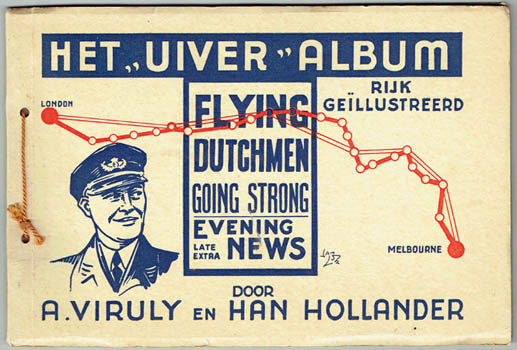
VIRULY, A. & Han HOLLANDER. Geillustreerd Album ter Herrinering aan de Londen-Melbourne Race. Amsterdam, Vlieger [1934]. Oblong octavo publisher's illustrated wrapper, string tied; 64pp, photo illustrations. A nice copy. sold
Commemorative book for the Melbourne Centenary or MacRobertson Air Race. The Dutch KLM plane Uiver arrived second and won on handicap.
Trove, backed up by precautionary searches of individual catalogues, finds two copies in Australia and OCLC finds only one outside the Netherlands.
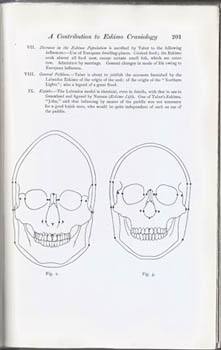
English head hunters
DUCKWORTH, W.L.H. Studies From the Anthropological Laboratory the Anatomy School Cambridge. Cambridge Univ Press 1904. Octavo, endpapers spotted but very good in publishers cloth (the spine a touch dulled); x,291pp, some photo illustrations, drawings and tables through the text. Au$125
The anthropology collection at the Museum of Human Anatomy at Cambridge - now incorporated into the Duckworth Collection - is the glory of British head-hunting. It contains thousands of skeletal remains, mostly skulls, of humans and primates. Duckworth begins with an introductory account of the museum before heading into a number of papers on morphology and descriptions of specific skulls, or groups of skulls.
Much of course is of local interest - there are large numbers of Aboriginal skulls. Their return was demanded by Australian aborigines but refused by the Museum - on grounds that may seem more valid than the original purpose for their collection: recent advances in genetic analysis offer more cogent explanation of racial relationships than the primitive theories of 19th century anthropologists. The same reason they were collected.
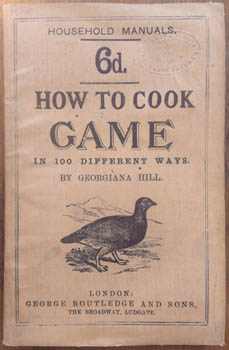
HILL, Georgiana. How to Cook Game in a Hundred Different Ways. London, Routledge 1867. Small octavo publisher's printed limp cloth; 64pp. Two defunct stamps of the Launceston Public Library on the title; a rather good unused copy. Au$90
With the contemporary blindstamp of the Launceston booksellers Walch Bros & Birchall. This, we might think, was imported to Tasmania as a handy guide for cooking local produce like wallabies and native wildfowl but it coincides exactly with the full-blooded efforts of the newly formed Acclimatisation Society who let loose deer and grouse and pheasants and all manner of imported game animals on an industrial scale.

WOOD, H.F. [Harry Freeman]. The Englishman of the Rue Cain. London, Chatto & Windus 1889. Octavo publisher's illustrated cloth blocked in black and grey (spine faded and a bit rubbed). Canted but rather good and fresh inside. Au$135
First edition of this murder mystery set in Paris involving a missing heir, cross dressing villains, a cavalcade of detectives and all manner of complications.

[ERSKINE, Thomas]. Armata. A fragment. [with] The Second Part of Armata. London, John Murray 1817. Two volumes octavo, together in 19th century half calf, spine elaborately gilded. A bit of browning, a handsome pleasing copy. Au$750
Second editions of both parts. This now obscure Antarctic imaginary voyage to another world connected to ours at the south pole might have been popular, in a mild and genteel way: there were supposedly five editions of the first part in 1817 and the second part likewise reached five editions by 1819. It is possible they were manufactured as part of Erskine's joke in the preface of part two that histories such as this were doomed to obscurity whereas if he called it a romance it was guaranteed two editions at least by the lending libraries alone. While the first and second edition of the first part are different settings, the second and fourth editions are from the same setting. The first and second editions of part two are from the same setting, as is the fourth edition up until signature K which is where Erskine added some footnotes.
Erskine's Armata is dystopian in intent but he is too polite and good natured to go overboard about it and although a couple of hundred or so sailors, from earth and from Armata, are obliterated at each end of the book they are dispatched in a sentence each. Even the narrator's beloved Morvina, who is literally killed by her induction into society, is done to death in a quiet half page, the narrator apologetic for being tactless enough to mention it. But, skimming past the legal religious stuff - I couldn't follow the outrageous fraud the clergy put over the government and justice system - there are some delightful scenes of bone crunching mayhem once Armata society sets off for an evening out.
Erskine, now almost as obscure, was once described as the "greatest advocate as well as the first forensic orator who ever appeared in any age" (James High as quoted in Patterson's 'Nobody's Perfect'). He remained all his life a fierce defender of freedom of speech and the liberty of the press with one startling lapse: after defending Thomas Paine at the cost of his own position he prosecuted a bookseller for distributing Paine's writing. Apparently he later returned the retainer in remorse but he remained open to accusations of self interest in that case.

Catalogue - Circus wagons. Beggs Wagon Co. Kansas City, Mo. Beggs Wagon Co. Manufacturers of Circus Wagons, Band Wagons, Ticket Wagons, Cages, Calliopes, Racing Chariots ... Kansas City, Mo [c1910]. 14x20cm publisher's illustrated wrapper; 16pp, illustrated throughout. Insignificant signs of use. Signed on the back by J.W. Begg. Au$600
Fabulous and rare. I didn't know there was such a thing as a circus wagon catalogue until I saw this. There was a reprint of this done in the seventies but I can't find another copy of the original anywhere.
Beggs started in the wagon business in 1875, expanded into show business around the time of this catalogue then turned to automobiles which took them into the twenties but no further.
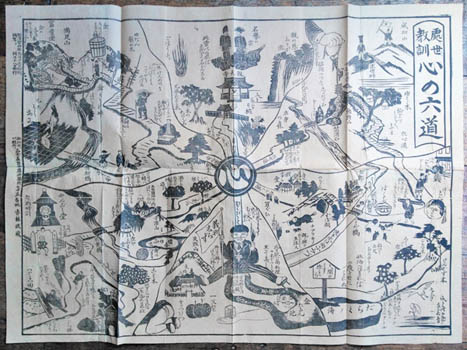
心の六道 [Kokoro no Rokudo]. n.p. 1911 (Meiji 44). Woodcut 42x57cm. Folded, some repairs to folds. Au$100
I have no clue what this is and how it relates to the Buddhist six roads. Shoji Hamada made a drawing similar in many ways, probably in the thirties, and I have seen another drawing apparently based on Hamada's drawing and that's all I can find. Despite translating some of the captions it remains a mystery to me.

Kuriki Kojiro. 教訓漫画双六 [Kyokun Manga Sugoroku]. Tokyo, Shogaku 1927 (Showa 2). Colour broadside 54x78cm. Some splodges and a small hole, not a bad copy. Au$325
The new years gift from the boy's first grade magazine of the Shogaku stable. A bright sugoroku in which, as I see it, most of the fun is what we are warned against. The title was used for more than one sugoroku.
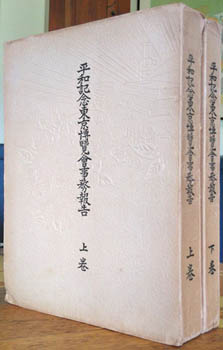
Exhibition - Tokyo 1922. 平和記念東京博覧会事務報告 [Heiwa Kinen Tokyo Hakurankai Jimu Hokoku]. Tokyo Fucho 1924 (Taisho 13). Two volumes 26x19cm, publisher's embossed wrappers; 681pp, heaps of illustrations: folding colour plans, architectural elevations and plans, photo plates, etc. Minor browning, less than expected from the paper; corners bumped, hinges of the wrapppers with short tears at the ends; a rather good fresh copy. Au$1,300
The official report on the 1922 Tokyo Memorial Peace Exposition is the very model of what an official report on an exhibition should be. You could just about rebuild the whole thing from this. The detail extends to measured drawings of light fittings, plans of the garden beds and coloured reproductions of the tickets and advertising.
The 1922 Peace Memorial Exhibition, celebrating the League of Nations and a bright future, was the most lavish national Expo ever held. The pavilions were a mix of stately, ultra modern and funfair fairy tale.
![]()
You can email an inquiry
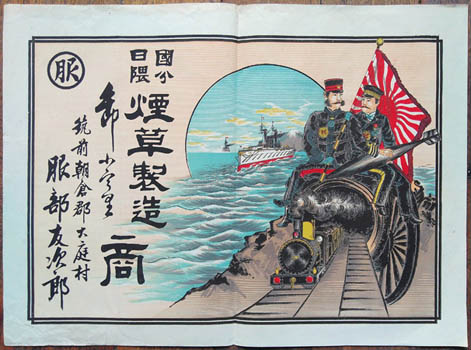
Hikifuda. 煙草製造商 [Tabako Seizo Gyosha]. n.p. [c1904]. Colour lithograph 38x52cm. Old vertical fold, a bit rumpled with a short tear repaired. Au$175
Freudians and symbolists of the last century, eat your hearts out. Our artist beat you to every punch by years. This patriotic hikifuda - large handbill or small poster - advertising tobacco must date to the Russo-Japanese war. This is the second copy of this I've come across; the other advertised transport. Classic images like this are adaptable.

Secession. A New State. Proposed Separation of Northern New South Wales. A statement ... by the committee appointed at a public meeting held in Grafton, in January, 1915. Grafton, Argus Print [1915]. Octavo publisher's printed wrapper; 24pp. Used, with some small chips from the wrapper and a vertical fold. Inscribed with complements by J.R. Kelly, presumably a secessonist. Au$125
Attempts by the northerners to get out of what was an unfair relationship between the district above 30 degrees south and the centre of power and spending, too far away down south, date back to the mid 1850s and resurfaced several times. Earlier secessionist attempted to join Queensland; from the time of this pamphlet through the twenties the push was for a new state. Trove finds only the NL copy.

Nakamura Susumu [&] Hosokibara Seiki 新案スポーツ双六 [&] 運命運勢獨占盤 [Shin'an Supotsu Sugoroku [&] Unmei Unsei Dokusen-ban]. Tokyo, Asahi Jan 1, 1929 (Showa 4). Broadsheet 54x79cm, colour game on one side, game printed in blue on the other. Quite good. Au$400
1929's new year gift from Asahi is a stylish if fun-free game of sports. No smiles here, winning is a serious business. What I learn from this is that if you want to meet girls then table tennis is the game. Nowhere else are they in sight.
The game on the back is outwardly much plainer but it is fun; there are a lot of pretty good drawings and cartoons by Hosokibara Seiki.

KELLY, Hugh. The Romance of An Hour, a comedy of two acts, as it is performed, with universal applause, at the Theatre Royal in Covent-Garden. London, for Kearsley 1774. Octavo modern plain wrapper; [4,8],44pp with publisher's advert on the last page for four other Kelly plays. A rather good copy. Au$800
First edition of this up to the minute Anglo-Indian farce by the literary hack, virulent anti-American independence critic and ministry mouthpiece. Kelly's biographer, Robert Bataille, was surprised that Kelly announced his authorship so early - the first production was on December 2 and this printed edition was on the street by the 17th - given that an earlier play had been disrupted by rioting Wilkites. I suggest it was hope for riotous publicity that made Kelly put his name on the title. The play got a lot of poor, a few warm reviews and not much attention despite being, as I said, filled with current fads.
The only truly admirable character is the Indian servant who is made, poor thing, to sound to us more like an American Indian in an old cowboy film than any Indian. He says everything but "heap big wampum". The heroine is a charming Anglo Indian aristocrat who has two well bred Englishmen competing for her hand despite her tint and Tahiti is thrown in: the latest chart is introduced and Bataille suggests that Kelly was capitalising with his noble native servant, on Omai, then in England.
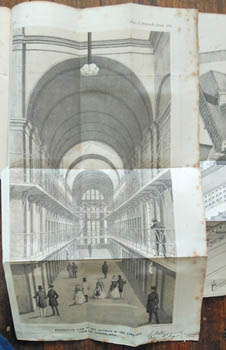
[JEBB, Joshua.] Report of the Surveyor-General of Prisons on the Construction, Ventilation and Details of Pentonville Prison, 1844. London, HMSO 1844. Large octavo modern cloth backed boards; 30pp and 22 folding plans, elevations and views. Spots and signs of use - a couple of closed tears - to the plates, a rather good copy. Au$950
A good account of the planning and construction of Jebb's prison, the model for modern prisons for the rest of the century. Pentonville was planned, built and run as an experimental model; six years later Jebb announced the experiment satisfactorily concluded. The plates range from a large and handsome isometric view of the prison through to details of the cell doors and windows, a hammock, the toilet, the prison's gong ... and a charming large tinted litho view of the main hall.
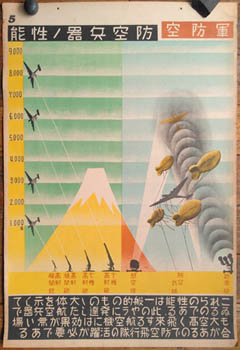
国民防空図譜 [Kokumin Boku Zufu]. Tokyo, Japan Air Defence Association 1941 (Showa 16) Title or cover leaf, colophon leaf and 35 numbered colour lithograph posters 75x51cm. First two leaves ragged but essentially complete, posters 14 to 25 have a top corner chewed only affecting the numbers and the very corner of the image on four or five. Definitely a used set, with some browning and torn or chipped edges on several; still a remarkable survival. Each sheet has two punched holes at the top which shows they were cord tied or pinned together and doubtless used for lectures. Au$8,500
Apparently a complete set of air defence posters, there is nothing to suggest there were any more. Not being able to find another set anywhere doesn't help. The National Diet Library has a set of 1944 posters which they illustrate on line. There are 38 posters in that set and a contents leaf. A few are much the same as ours but most have been redrawn and reorganised. By 1944 things weren't going so well and the last few posters in that series detail bandages. I found a passing mention of a 1943 set with 37 posters but no details. I can't find any mention of the existence of this set.
These were published on the 16th of October, nearly two months before Pearl Harbour when Japan was at war with no-one but China and maybe France - but France didn't really exist anymore. As far as I'm aware civil defence literature up until this consisted of a small set of quite pretty posters produced in Kyoto, brochures and pamphlets. Civil defence was a matter for local authorities. Didn't the appearance of a big set of air defence posters trigger alarm anywhere? But the US expected Japan to attack closer targets, mainly the Philippines, and maybe poster 2 helped convince them they were right.
With what I have managed to glean of the history of air defence in Japan these brave and bright graphics look much darker. I can't decide how much of the misleading futility of these is naive optimism and how much is cynical disregard for the people. When the air defence act was passed in 1937 no-one expected any attack from China. The act was more a matter of population control and preparation. Perhaps most brutal was that useful residents were forbidden to evacuate the cities in case of air raids; they were needed for production. They were to stay and fight; with brooms, blankets and buckets if they had to. At HQ the whole population was considered cannon fodder. These regulations were strengthened in late 1941 - just about the time these posters appeared - and again in 1943. This was enforced right until the end.